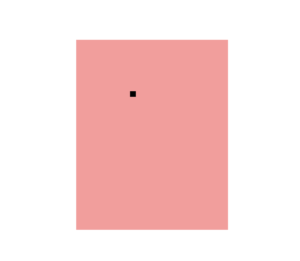Too often we live deadline to deadline, making excuses that we will give more time for our relationships or our health after getting that promotion or turning in that specific assignment. And perhaps we do until the next deadline or “level” inevitably strikes. Through Rat Race, I hoped to convey an escape from a life of sleepwalking. In this system, game objects, layout, and freedom of movement are essential elements of my game design, allowing the player to explore this theme through the context of play.
I envisioned the player in a mad race to collect something deemed valuable, but also wanted to show that this specific object was worthless at the end of the day. After struggling with making P5.play’s collision function work with an ellipse, I settled on a green rectangle rotated slightly, though this object could have been designed more abstractly to convey what we want most at an individual level rather than be so strongly associated with money and success. When a player collects the green rectangle, their score increases by 10, demonstrating its value at a surface level. I placed these objects above the player and had them reappear quickly (every 2-3 seconds) to create an instant gratification for the player and create the desire to collect more as quickly as possible while moving upward towards an end. I also wanted to create an object that had no seeming purpose so that the player could redefine what is of value in the game and be reminded of the importance of the little things in life. The saying “stopping to smell the roses” came to mind and hence, the flowers were created. I placed the flowers in locations where the player would have to retrace their path to collect it to challenge the notion that life is a linear progression. When the player collected the flower, there was no feedback other than the flower being removed. I debated this design choice heavily, but decided that since I wanted to user to explore rather than win, I didn’t need to indicate the number of flowers collect. Instead collecting flowers had a less immediate impact, discernible only in the changes to the layout of the game board.
When a flower was collected, I added a new color to the array of colors the background would loop through. Thus, the game background began as gray and became more colorful (looping through more colors) to signify a different richness in life. Additionally, I decreased the number of walls in the maze to signify a breaking free from the path defined by society. Additionally, every other wall also had another sprite who was on their own path. When the player collides with another sprite, they will get sucked into the other’s path unless they take the action to leave that influence.
With more time, I think I could have improved the graphics of the game to be a more cohesive visual experience. I think the flowers detracted from the overall impression of the game in terms of their design and the slightly off collision function. I am, however, satisfied with how the design components created meaning and I think I was able to convey my point across based on conversations with friends who playtested. One friend summarized these two sentiments quite well: “I feel existential now. It was surprisingly impactful for a game that looked like shitty Donkey Kong.”
In The Routledge Companion to Video Game Studies, the authors discuss how video games are material, software, and cultural artifacts. When I first read it, I didn’t quite understand what Perron and Wolf meant by “the procedural aspects of the meaning making process,” but through creating the game and considering what meaning I wanted the player to elicit from interacting with various components of the system, I was able to understand how Rat Race is a software and cultural artifact. Additionally, though an artifact physically created by me, Rat Race is abstract enough that the player can interpret their own meaning of the escape and this individual decision is reflective of the juxtaposition, should it exist, between the values of a culture and those of the individual.

Escaping from the rat race
Link to game: https://simranparwani.github.io/ratRace/
Link to code: https://github.com/simranparwani/simranparwani.github.io/tree/master/ratRace